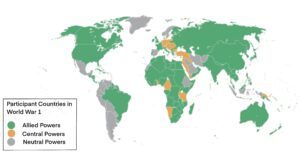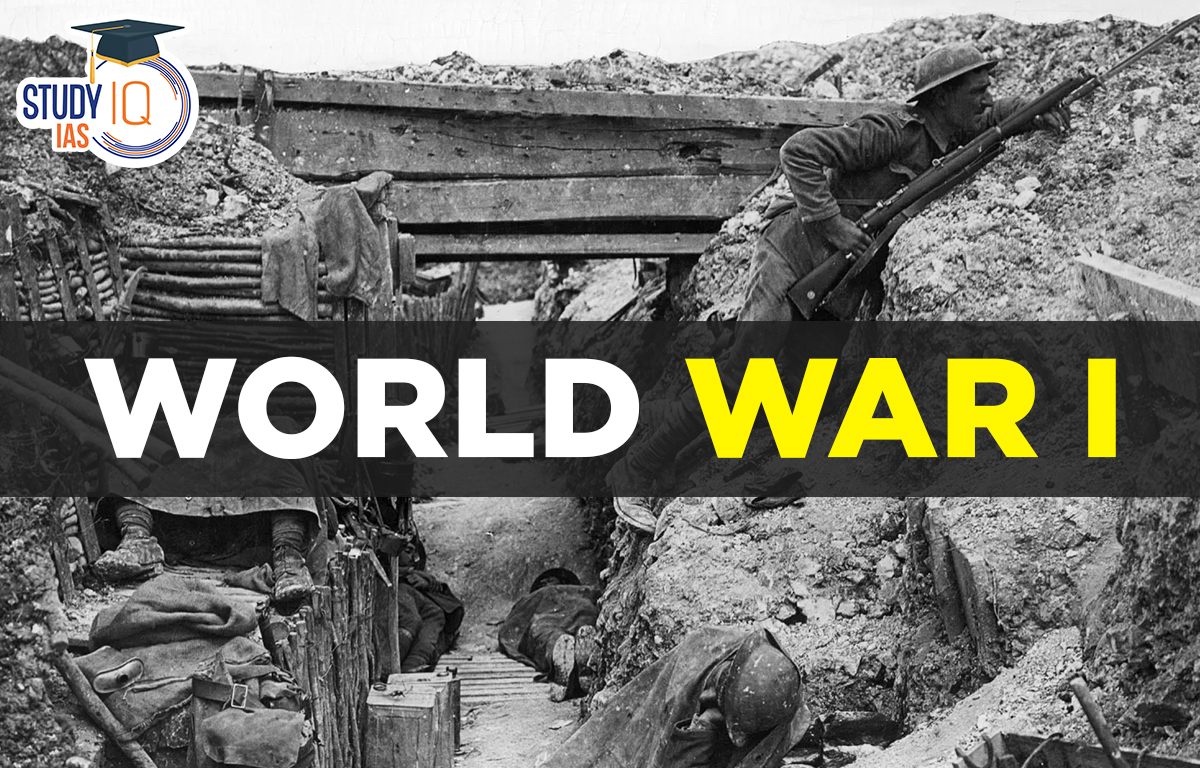Table of Contents
World War 1
World War 1, also known as the Great War, was a Global war it originated in Europe that lasted from 28th July to 11th November 1918. It was also described as the “War to end all Wars”, which led to the mobilization of more than 70 million military personnel; including 60 million Europeans making it one of the largest wars in history. An estimated 11 million personnel, including 6 million civilians died and 20 million were wounded. It was fought throughout the world comprising many countries in all three modes land, air, and water.
Read More: World War 2
World War 1 Powers
There were two main groups in World War 1 i.e, Allied Powers and Central Powers.
| Allied Powers | Central Powers |
|
|
Read More: American Revolution
World War 1 Countries Map
Here is the World War 1 Countries Map for a better understanding of which countries supported which power.

Causes of First World War
While a number of events directly contributed to the conflict, the main causes are much more complex and the subject of ongoing dispute. The major causes of World War 1 that are frequently cited are summarised below in detail.
Militarism
Arms race among countries like Britain and Germany. Their entire industrial complexes were used for military equipment. As the world entered the 20th century initiated the arms race among the major powers of the world.
Germany by 1914 had the greatest increase in militarization backed by its large army, Mechanization of guns, Torpedoes, and large naval ships. This increases the militarism push between the countries which ultimately leads to war.
Growth of Imperialism
All the powers in Europe wanted to make colonies. They had made large colonies in Africa and Asia, and they had the scramble for Africa, i.e., running for more areas to colonize. Britain led in imperialism and everyone wanted to compete. Britain alone had control over 1/4th of the world. They had vast resources and manpower at their disposal for the great war. India has sent 13 lakh soldiers to fight for Britain.
Growth of Nationalism: By the 19th century Europe was swept by a wave of nationalism. Countries like Germany, Italy, and other Baltic states were getting unified. It was believed whenever war happened a country gets Independence as they believed in the ‘Glory of War’.
Read More: Industrial Revolution
Mutual Defense Alliances
Countries around the world always have adopted the ideology of making mutual defence agreements with neighbouring countries, and as a result of these agreements, many countries were pulled into the war. Multiple secret alliances in Europe since the 19th to maintain the balance of power. The two main alliances were:
| Triple Alliance, 1882 | Triple Entente, 1907 |
| Included Germany, Austro-Hungary, Italy | Included France, Britain, Russia |
Read More: French Revolution
World War 1 Immediate Cause
The assassination of Archduke Franz Ferdinand of Austria-Hungry and his wife by Bosnian nationalist, Gavrilo Princip and other members of the Black Hand in Sarajevo, Bosnia on 28th June 1914. Black had organization was supported by Serbia.
Read More: Revolt of 1857
World War 1 Timeline
Here is a complete World War 1 Timeline given below in the table with details:
| Timeline | Details |
| July 1914 | Austria-Hungary declared war on Serbia, marking the beginning of WW I. |
| September 1914 | Allied forces halt Germany’s advance into France during the Battle of the Marne. |
| May 1915 | Italy declared war on Austria-Hungary. |
| July 1916 | Allied powers’ offensive begins the Battle of Somme. |
| April 1917 | The USA declared war on Germany. |
| December 1917 | Russia signed a ceasefire with Germany after Russian Revolution. |
| May 1918 | US forces won the battle of Cantigny the 1st independent US operation. |
| September 1918 | Allied forces begin to attack Meusse-Argonne the final offensive of the war |
| January 1919 | The peace conference begins in Paris. |
| February 1919 | Draft of the covenant of the League of Nations is completed |
| June 1919 | Allied and German representatives signed the treaty of Versailles. The US signed the treaty of guaranty, pledging to defend France in case of an unprovoked attack by Germany |
| January 1920 | Treaty of Versailles takes effect |
| March 1920 | US Senate fails to ratify the Treaty of Versailles for the second time. |
| August 1921 | The US signed a separate peace treaty with Germany, Austria, and Hungary. |
Read More: Indigo Revolt
Events Leading to World War 1
There are the subsequent series of events occurred that led to the First World War.
July Crisis
Austria-Hungary asked Serbia to surrender with humiliating terms for their support to the Black hand organization in the assassination, due to which Serbia asked for the support of Russia on other hand Austria-Hungary asked for the support of Germany. Russia and France came in support of Serbia and declared war on Germany. France came in support of Russia because of the triple entente. As these events took place in July 1914 hence it is called July Crisis.
The German army marched into Belgium to enter France, as Belgium was initially neutral but Belgium and Britain had the ‘Treaty of London’ of 1839, by which Britain was bound to help Belgium in war. Britain and Germany were also competitors in the arms race so war was bound to take place between them. British attacked Germany.
Germany initially got success in France, but as the war went to Stalemate, Germany could not go deeper into France. On other hand, Germany got huge success against Russia on its eastern front. Ottoman empire being an archenemy of Russia attacked it. Russia replied to the attack to maintain its influence over the Strait of Dardanelles. The main fight was in the Black Sea. Ottoman also attacked Suez Canal which was the British Link to India.
Read More: Mahatma Gandhi
Global War Aspects
Allied forces attacked the German Colonies in Africa like Togo, Tanzania, Cameroon and Japan ally of the UK attacked the Micronesian and Chinese colonies of Germany. Ottoman ships also bombarded the Black Sea port of Russia.
Entry of the USA in First World War
The USA was initially neutral and supplied weapons and warships to both sides. On 7th May 1915, RMS Lusitania a British ship sunk by a German U-boat, as a result, the death of 128 US citizens Led to the US declaration of war on Germany in 1917. In April 2017 finally, the USA involved in the war. Germany asked for the help of Mexico to battle against the USA.
Read More: Rowlatt Act
Russian Revolution 1917
Russian Revolution 1917: February Revolution overthrow Tsar Nicholas II and a provincial was formed which did not survive for long. October Revolution leads to the Bolsheviks party under Lenin coming to power in Russia who was against the war and signed a peace treaty with Germany called the ‘Treaty of Brest-Litovsk’ in March 1918. As the war on the eastern front ended Germany use the soldiers there in the war with the USA.
End of World War 1
The allied army pushed in from all sides like the Balkans, Italy, the Middle East, western front, and soon overrun the central power. On the western front with daily 10,000 fresh soldiers from US allies defeated the German Army. On 11th November 1918, German signed the Ceasefire. World War 1 won by the Allied powers including Russia, France, Britain, the USA (1917-18), Japan, and Serbia.
Read More: Khilafat Movement
Treaty of Versailles 1919
It was a 6-month-long negotiation held at the Palace of Versailles, Paris. The culprits of war were placed upon the central powers, especially Germany. Germany agreed to pay war reparations to Britain and France, the war repatriation was so heavy that Germany paid its last instalment in 2010. The colonies of Germany were divided between Britain and France. The USA did not get any colonies because it was against Wilson’s 14 points.
Read More: Jallianwala Bagh Massacre
Aftermath World War 1
Health: Million died due to disease as there were no antibiotics at that time (discovered in 1929). Spanish flu killed 50 million between 1918 to 1920. The male population declined heavily in Europe, according to the 1921 census of 1921 of UK the sex ratio was 13000 females per 1000 males
Economic: Great Britain went from an investor to a debtor (from the USA). The USA strengthened its economy immensely and had a great growth period between 1920 to 1929 till the Great Depression of 1929 crashed the market.
Political: British and French empires consolidated their power. Rise of National Socialism or Nazi Party (Hitler) in Germany. League of Nations was established as the 1st International organization to maintain peace in the world. It was formed according to the 14 points mentioned by Wilson.


 Important Lakes of India, State wise and...
Important Lakes of India, State wise and...
 Buddhism History, Origin, Sect, Councils...
Buddhism History, Origin, Sect, Councils...
 Andaman and Nicobar Islands, History, Cl...
Andaman and Nicobar Islands, History, Cl...





















